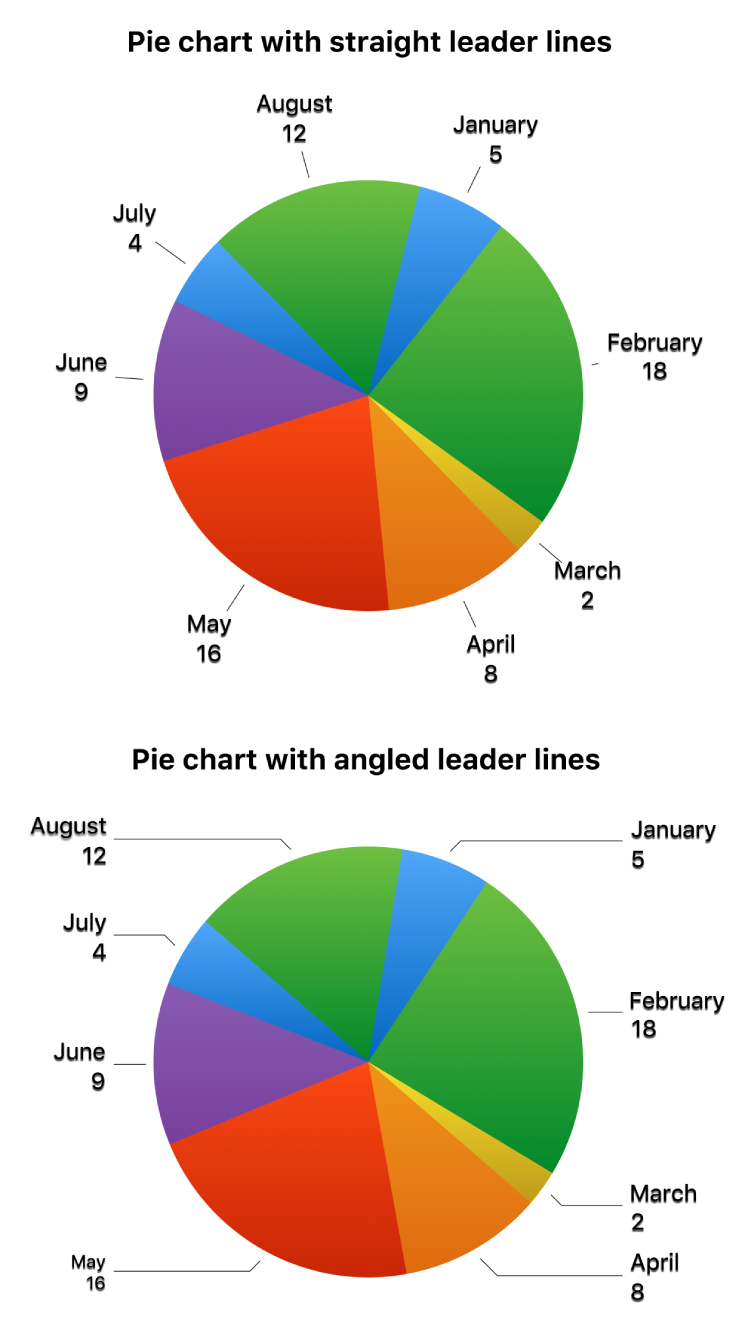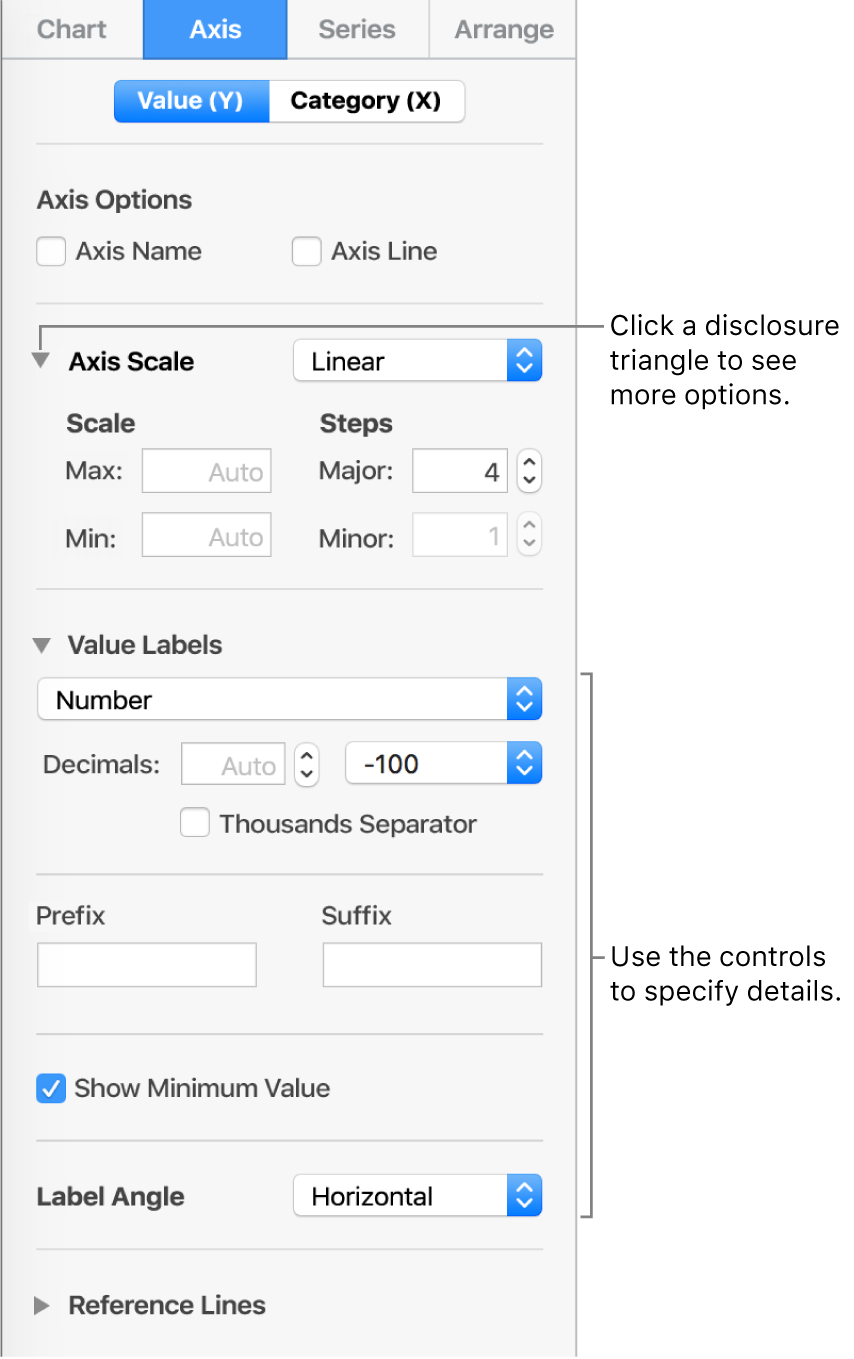
Change the look of chart text and labels in Keynote on Mac
You can change the look of chart text by applying a different style to it, changing its font, adding a border and more.
Change the font, style and size of chart text
You can change the look of all the chart text at once.
Click the chart, then in the Format
 sidebar, click the Chart tab.
sidebar, click the Chart tab.Use the controls in the Chart Font section of the sidebar to do any of the following:
Change the font: Click the Chart Font pop-up menu and choose a font.
Change the character style: Click the pop-up menu below the font name and choose an option (Regular, Bold and so on).
Make the font smaller or larger: Click the small A or the large A.
All text in the chart increases or decreases proportionally (by the same percentage).
To learn how to style the chart title and value labels so they look different from the other text, see the topics below.
Edit the chart title
Charts have a placeholder title (Title) that’s hidden by default. You can show and rename the chart title.
Click the chart, then in the Format
 sidebar, click the Chart tab.
sidebar, click the Chart tab.Select the Title tickbox.
Double-click the placeholder title on the chart, then type your own.
To change the look of the title, such as its font, size and colour, double-click the title again, then use the controls in the Chart Font section of the sidebar to make changes.
To move the title to the centre of a doughnut chart, click the Title Position pop-up menu, then choose Centre.
Add and modify chart value labels
Charts have labels that show the values of specific data points. You can choose a format for them (for example, number, currency or percentage), change where they appear and more.
Click the chart, then in the Format
 sidebar, click the Chart tab.
sidebar, click the Chart tab.Do any of the following:
For bubble charts: Click the disclosure triangle next to Bubble Labels, select the tickbox next to Values, then click the pop-up menu and choose a value format.
For scatter charts: Click the disclosure triangle next to Value Labels, select the tickbox next to Values, then click the pop-up menu and choose a value format.
For other types of chart: Click the disclosure triangle next to Value Labels, then click the pop-up menu and choose a value format.
To hide the value labels, deselect the Values tickbox or choose None from the pop-up menu.
Fine-tune the value labels (these controls are available only for some chart types):
Set the number of decimal places: Click the up or down arrow.
Show the thousands separator: Select the Thousands Separator tickbox.
Add a prefix or suffix: Enter text. It’s added to the beginning or end of the label.
Specify where labels appear: Click the Location pop-up menu and choose an option, such as Top, Middle, Above or Inside (the options depend on your chart type).
To change the font, colour and style of the labels, click any value label on the chart, then use the controls in the Font section of the sidebar to make changes.
Only the labels for the selected data series are modified. To change labels for another series, click one of its labels, then make changes.
To select multiple series, click a value label, then Command-click a value label in another series. To select all series, click a value label, then press Command-A.
Note: The font for the value labels also changes when you change the font for the entire chart.
Add and modify pie chart wedge labels or doughnut chart segment labels
You can show the wedge or segment labels in a pie or doughnut chart, specify a format for them (for example, number, currency or percentage), and change how they look.
Click the chart to change all item labels, or click one item label to change it.
To change several item labels, Command-click them.
In the Format
 sidebar, click the Wedges or Segments tab.
sidebar, click the Wedges or Segments tab.To add labels, do any of the following:
Show data labels: Select the tickbox next to Data Point Names.
Show data values: Select the tickbox next to Values.
To hide a label for a particular item, select the label, then deselect Values or Data Point Names.
To format the labels, click the disclosure triangle next to Value Data Format, then do any of the following:
Change the number format: Click the Value Data Format pop-up menu and choose a format (percentage, for example).
Set the number of decimal places: Click the up or down arrow.
Show the thousands separator: Select the tickbox next to Thousands Separator.
Choose how to display negative numbers: Choose “-100” or “(100)”.
Add a prefix or suffix: The text you enter in these boxes is added to the beginning or end of the label.
To position the labels and add leader lines to connect them with their items, click the disclosure triangle next to Label Options, then do any of the following:
Change the position of the labels: Adjust the Distance from Centre slider to set where the labels appear. Moving the labels further from the centre of the chart can help separate overlapping labels.
Add leader lines: Select the tickbox next to Leader Lines. You can change the style, colour and thickness of the leader lines and add endpoints to them.
Click the pop-up menu and choose Straight or Angled. With angled leader lines, the callouts align into columns, as shown below.

To change the font, colour and style of item labels, click any item label on the chart, then use the controls in the Font and Shadow sections of the sidebar to make changes.
Modify axis labels
You can specify which labels appear on an axis, edit their names and change their angle of orientation.
Click the chart, then in the Format
 sidebar, click the Axis tab.
sidebar, click the Axis tab.Do either of the following:
Modify markings on the value axis: Click the Value (Y) button near the top of the sidebar.
Modify markings on the category axis: Click the Category (X) button near the top of the sidebar.
Use the controls in the sidebar to make any adjustments.
To see all options, click the disclosure triangles to the left of the section headings.

If you selected the Axis Name tickbox and want to change the name on the chart, click the chart, double-click the axis name on the chart, then type your own.
Note: Y-axis options may be different for scatter and bubble charts.
To change the font, colour and style of axis labels, click an axis label, then use the controls in the Font section of the sidebar to make changes.
To add a caption or label to a chart, see Create a caption in Keynote on Mac.